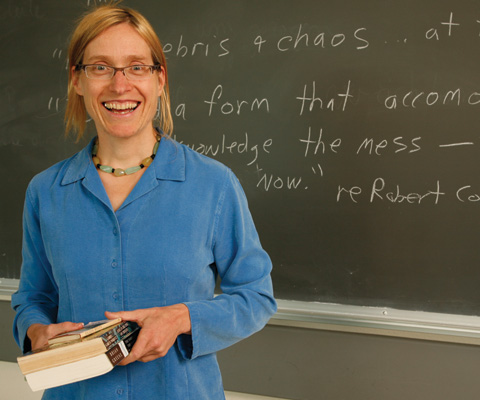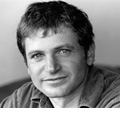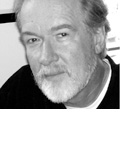By Rachel Howard
The newest additions to the Creative Writing faculty are helping guide the next generation of gifted poets, playwrights and fiction writers.
A cowbell rings out through the fifth floor of the Humanities building. Associate Professor Nona Caspers (M.F.A., '95) stands before a dozen students with the rusty antique in her hand, grinning as she tolls it. She tells a story of her father calling in the cows, noting the clarity of his voice as he marked the fall of evening. Then she has the whole class practice an ear-piercing cattle call in unison. It all sounds like raucous fun -- so much so that a classroom down the hall closes its door -- but making nimble verbal leaps from her childhood in Minnesota to existentialist philosophy, Caspers moves to a more serious message.

There's wild enthusiasm in Nona Caspers' bright face as she talks to her class about "how sound and language hold time, make time." She scans the classroom. "Ithink that's crazy," she says, while her students nod. "Don't you?" — Photo by Margo Hartford
"When we're writing, we're reaching for deep time," she says, wide-eyed. "I don't think we're saying ?my contemporaries will like this.' Instead, something comes through the subconscious that wants to reverberate through the centuries. We want to reach out to the future and reach out to the past. It's like Heidegger, the past and the ?about to be': therein lies the tension."
For more than 50 years, gifted writers have come to SF State for this kind of inspiration. The graduate program in creative writing has long been one of the most well regarded in the nation, boasting best-selling alumni authors like Po Bronson (M.A., '95), Anne Rice (B.A., '64; M.A., '72) and Frances Mayes (M.A., '75). The program is also competitive, receiving on average 500 applications for 50 spots to study fiction, poetry or playwriting as either M.A. or M.F.A. students.
Acclaimed alumni span the centuries, as do lauded faculty: Kay Boyle taught here in the 1960s and '70s, as did National Book Critics Circle Award winner Gina Berriault in the '80s. But recently, the creative writing program has been reinvigorated by a new wave of teaching talent. Poets Paul Hoover and Camille Dungy joined the faculty last year, while newly tenured fiction writers Caspers and Peter Orner came aboard in 2002, a double hire for what was supposed to have been a single position. "The students said they didn't want us to have to choose," says poet and novelist Maxine Chernoff, who has chaired the department since 1995. "I was so happy the day I was told we could hire them both. It's a rich time here."

Writing Advice
For me, reading and writing -- particularly reading -- are kind of like breathing. And so I try to take them both slowly, most of the time.
Associate Professor Peter Orner
The new faculty members are diverse in their styles of writing. Hoover, an irrepressibly experimental poet who lives outside the genre's cliquish bounds of "schools," edited "The Norton Anthology of Postmodern American Poetry." Dungy is on the verge of releasing a boundary-breaking anthology of African American nature poetry. Caspers won the prestigious Grace Paley Award for her quietly lyrical short story collection "Heavier than Air." Orner's latest book, "The Second Coming of Mavala Shikongo," the tale of an American teacher in a desolate region of Namibia, won the Bard Fiction Prize.
All are excited to teach at SF State. "I find the writing by students at State to be more eclectic and risk taking and innovative than at any place I've been associated with, and that includes the University of Iowa," says Orner, a graduate of that hallowed program. "The students at State aren't yet professional writers, but they're already good. The program attracts a certain kind of student, one who doesn't need hand-holding."
Aside from the benefits of San Francisco's vibrant literary scene and SF State's vital Poetry Center -- with its massive recording archive and almost weekly visits by renowned poets -- students thrive on an unusual curriculum.
Most creative writing programs rely heavily on critique workshops, which can be a valuable source of feedback from peers, but can also veer toward a stifling revision by jury. At SF State the course load is split between "workshop" and "process" courses, such as Caspers' class on "The Uses of Time in Narrative." Process classes look at published writers' work from a writer's point of view -- and faculty members are free to design them however they like. Orner has taught classes on humor and "The Oddly Structured Novel," while Hoover has taught about "Poetry Machines" and Caspers has tackled "The Aesthetics of Everyday Life."

Writing Advice
Ron Carlson once told me, 'The writer is the person who stays in the room. That's the beginning, middle and end of it.' I have that quote taped to my study door so as I try to leave my desk, for whatever reason, I have to think about it first.
Associate Professor Camille Dungy
There's a similar freedom in the way the professors run their workshops. In addition to the required reading on his syllabus, Orner brings in especially impressive stories whenever he stumbles upon them. Hoover says he prefers to lead in-class writing: "The way I teach is more like easel-painting instruction." If Caspers is workshopping a novel set in, say, Burma, she'll bring in a map "so we can locate ourselves and enliven the exchange." In a poetry workshop, Dungy told her students to "bring in a poem you admire, and it doesn't have to be in English. Faces lit up."
The common denominators are energy and respect for their students. "We don't put writers up on a pedestal," Orner says of his process classes. "Even Borges is just a guy who sat down to write like you and I."
Clearly, the approach is working. As Hoover notes, "It's not unusual for a student to graduate and get a book contract quickly." One such student is Robin Romm (M.F.A., '05), who won the program's Michael Rubin Chapbook Award for her short stories. Less than two years later her collection "The Mother Garden," mostly written during her time at SF State, was published by Scribner and received a glowing review in The New York Times. "The program offered support and helped me to develop discipline and confidence," says Romm, who also swiftly landed a teaching job at the College of Santa Fe. She loved studying under Orner, who served as her thesis advisor, and Caspers. "Nona is amazing," she says. "She's just a great model of what it is to look closely at the world without expectations."
Even students who are still in the program are enjoying early success. Jan Ellison, who will graduate this spring, recently won an O. Henry Prize for her story "The Company of Men," published in New England Review.
"State taught me to see my own work more clearly over time and to know that a draft isn't finished," she says. "The program gave me structure, and the quality of writers is so high. I had terrific professors and was introduced to wonderful books I wouldn't have discovered on my own."

Writing Advice
The mystical Catholic priest Meister Eckhart has a sentence in one of his German sermons, 'I shall say again what I never said before.' That's good advice for poets. A poem dominated by the unfamiliar may be obscure and distant, while familiarity stands too close and offers truisms. By saying again what they never said before, the best poems make language and world seem new.
Professor Paul Hoover
Romm and Ellison embody what Caspers loves about SF State's writing students: "That intelligence that surpasses conventional intelligence." And the inspiration works both ways. All four professors say their teaching actually stimulates their own writing, especially because they're free to explore their latest passions in the process classes. "I see it as a trinity," says Dungy. "The teaching pushes me to read and to think about how to articulate the ideas that inform my own work. And that pushes me to keep writing."
A similar momentum is now coursing throughout the Creative Writing Department. The department's literary journal, Fourteen Hills, has been growing in reputation, while New American Writing, the journal Chernoff and Hoover, her husband, have coedited for 21 years, recently received University funding (see sidebar below).
And though the department is large and students' lives are busy, the sense of community, Chernoff says, has expanded. The Wordsmith Guild, a recently formed student club, now hosts frequent readings and events. Caspers has even been known to perform interpretive dance -- in an orange tutu -- at some of these gatherings.
Caspers' student Ellison says, "She's so energetic and has a fresh and different way of looking at literature." And that energy, along with that of her new colleagues, is taking a first-class writing program into the future.
"I love this program," Ellison says. "I think it's getting stronger all the time."